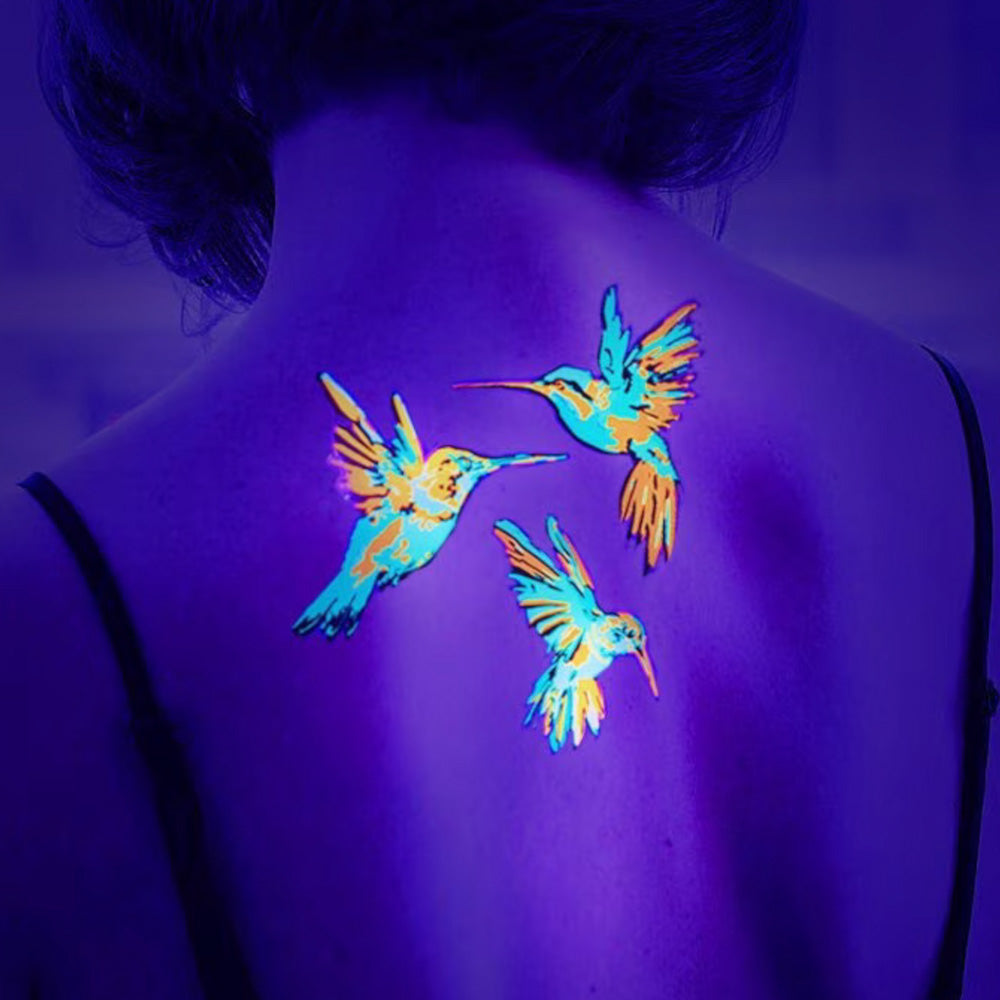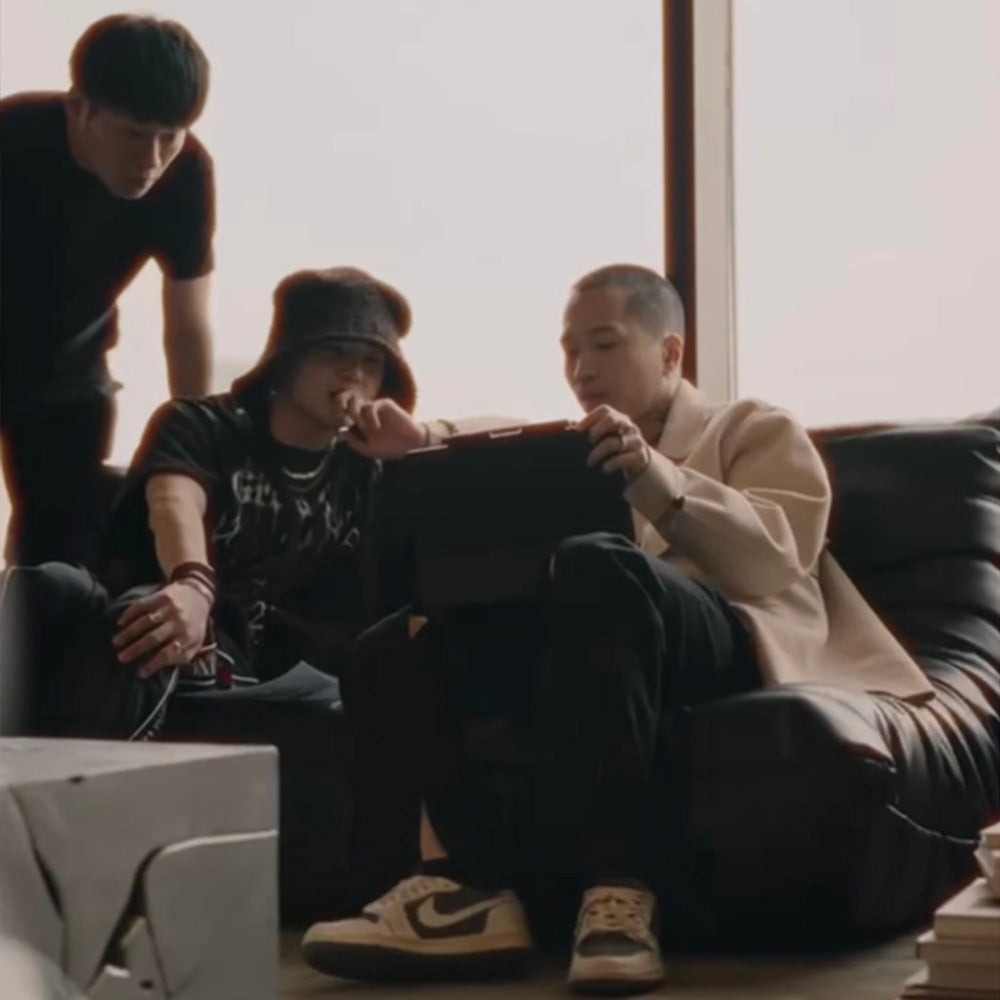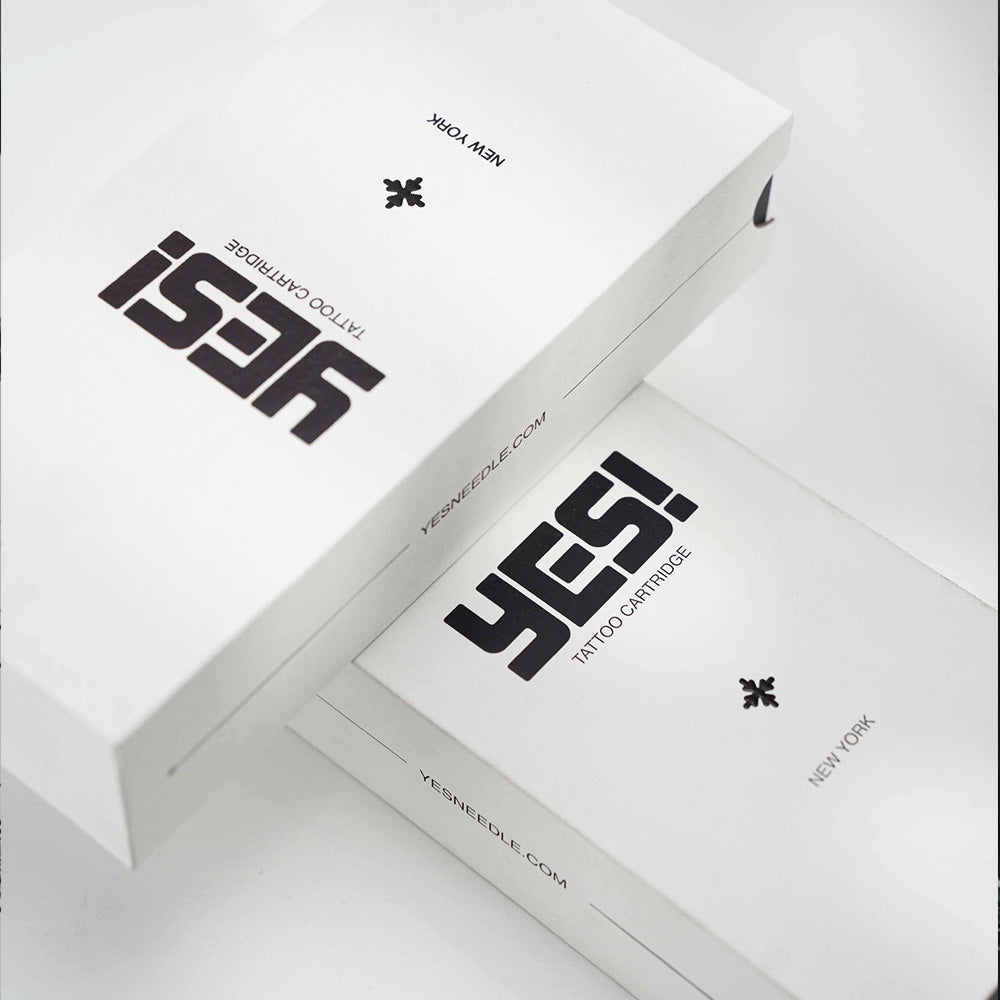Tattoo-Nadeln für dicke Linien: Ihr kompletter Leitfaden für kühne, saubere Linienarbeit
Ich habe auf die harte Tour gelernt, dass der Versuch, mit kleinen Nadeln dicke Linien zu ziehen, wie das Streichen einer Wand mit einer Zahnbürste ist. Sicher, man kann es tun, aber man verschwendet Zeit, traumatisiert die Haut unnötig und erhält trotzdem uneinheitliche Ergebnisse.
Ich habe meine ersten sechs Monate damit verbracht, genau das zu tun. Ich benutzte eine 7RL und ging drei-, vier-, manchmal fünfmal über dieselbe Linie und wunderte mich, warum meine traditionellen Stücke "unscharf" aussahen, verglichen mit den scharfen, kräftigen Konturen meines Mentors. Der Tag, an dem mir jemand die richtige Nadelkonfiguration zeigte? Das war der Wendepunkt.
Wenn du mit fetten Linien kämpfst oder gerade erst anfängst, lass mich dich durch alles führen, was du über die Auswahl und Verwendung der richtigen Tattoonadeln für dicke Linien wissen musst.
Warum dicke Linien wichtig sind (und kleine Nadeln nicht ausreichen)
Dicke, kräftige Linien sind nicht nur stilistisch, sondern auch die strukturelle Grundlage der wichtigsten Tätowierungsstile. American Traditional, Neo-Traditional, Japanisch, Tribal - diese Stile leben oder sterben von der Qualität der Linienführung.
Warum dicke Linien entscheidend sind:
Visuelle Wirkung: Kräftige Linien erzeugen Kontraste, die das Design "knallig" und in verschiedenen Räumen lesbar machen.
Langlebigkeit: Dickere Linien altern besser. Da sich Tattoos im Laufe der Jahre natürlich ausbreiten und verblassen, behalten dicke Linien ihre Definition besser bei als dünne.
Strukturelle Integrität: Bei großen Stücken halten dicke Linien die Designs zusammen, selbst wenn sie mit komplizierten Details gespickt sind.
Das Problem mit kleinen Nadeln
Viele Anfänger versuchen, dicke Linien zu ziehen, indem sie mehrmals mit kleinen Linern wie 3RL oder 5RL über Bereiche fahren. Das funktioniert nicht, weil:
❌ Übermäßiges Hauttrauma - Mehrere Durchgänge schädigen die Haut mehr als ein sauberer Durchgang
❌ Uneinheitliche Sättigung - "Aufbauen" führt selten zu einer gleichmäßigen Verteilung der Tinte
❌ Unscharfe Kanten - Linien sehen weich oder verschwommen aus, statt klar
❌ Zeitverschwendung - Was einen Durchgang dauern sollte, dauert vier oder fünf
❌ Unbehagen beim Kunden - Mehr Nadelzeit = mehr SchmerzenDie Lösung? Verwenden Sie von Anfang an die richtige Nadelkonfiguration.

Die besten Tattoo-Nadeln für dicke Linien
Basierend auf jahrelanger Erfahrung beim Testen verschiedener Konfigurationen sind hier die Nadeln, die sich für fette Linien eignen:
Runde Liner: Ihr wichtigstes Werkzeug
7RL - 9RL: Mittelstarke Linien
- Am besten geeignet für: Standardmäßige fette Konturen in kleinen bis mittelgroßen Tattoos
- Linienstärke: 2-3 mm
- Schwierigkeitsgrad: Einsteigerfreundlich
- Häufige Anwendungen: American Traditional Flash, gewichtete Schrift
11RL - 14RL: Extradicke Linien
- Am besten geeignet für: Starke Umrisse, großformatige traditionelle Arbeiten
- Linienstärke: 3,5-4,5 mm
- Schwierigkeitsgrad: Fortgeschrittene
- Häufige Anwendungen: Japanische Bodysuits, Tribal, kühne neo-traditionelle
18RL+: Ultradicke Linien
- Am besten geeignet für: Massive Stücke, extreme Tribal-Arbeiten
- Linienstärke: 5mm+
- Skill level: Fortgeschritten
- Häufige Anwendungen: Großflächige Schwarzarbeit, polynesisches Tribal
Warum runde Liner und nicht runde Shader?
Manche Künstler verwenden runde Shader (RS) für dicke Linien, weil sie mit weniger Nadeln mehr Fläche abdecken. Anfängern empfehle ich dies nicht.
Warum: RS-Nadeln sind lockerer gruppiert und erzeugen "unscharfe" Linien. Sie liefern Tinte für Schattierungen, nicht für präzise Linienarbeit. Die enge Gruppierung der RL-Nadeln sorgt für scharfe, saubere Kanten, die eine professionelle Arbeit ausmachen.
Sobald Sie Erfahrung haben, können Sie mit RS für bestimmte Effekte experimentieren. Aber beherrschen Sie zuerst die traditionellen runden Liner.
Needle Gauge Matters
#12 Gauge (0.35mm) - Standard ✅
- Beste Balance zwischen Tintenfluss und Kontrolle
- Was die meisten Profis verwenden
- Erzeugt solide, gesättigte Linien in einem Durchgang
#10 Gauge (0.30mm) - Dünner
Weniger Tinte pro Durchgang, besser für detaillierte Arbeiten
#13 Gauge (0.40mm) - Dicker
Mehr Sättigung, schwieriger zu kontrollieren
Für dicke Linien sollten Sie bei der #12 Gauge bleiben. Industriestandard aus gutem Grund.

Verstehen von Nadelkonfigurationen
Verstehen von NadelkonfigurationenWenn Sie wissen, wie Konfigurationen funktionieren, können Sie jederzeit das richtige Werkzeug auswählen.
Der Needle Code wird erklärt
Wenn Sie "1207RL" sehen:
12 = Feinheit (#12 = 0.35mm Durchmesser)
07 = Nadelanzahl (7 Nadeln in einer Gruppe)
RL = Konfiguration (Round Liner)
Wie sich die Nadelanzahl auf die Liniendicke auswirkt
3-5 Nadeln → Dünne bis mittlere Linien (1-2mm)
7-9 Nadeln → Mitteldicke Linien (2-3,5mm) ⭐ Vielseitigste
11-14 Nadeln → Extradicke Linien (3,5-4,5mm)
18+ Nadeln → Ultradicke Linien (5mm+)
Profi-Tipp: Der Sprung von 9RL zu 11RL ist beträchtlich. Wenn Sie sich unsicher sind, beginnen Sie mit 9RL - es ist nachsichtig und bietet eine beeindruckende Dicke.

Wesentliche Techniken für perfekte dicke Linien
Die richtige Nadel ist die halbe Miete. Hier erfahren Sie, wie Sie größere Liner effektiv einsetzen können:
1. Erhöhen Sie den Winkel der Maschine
Das war mein größter Durchbruch.
Mit kleinen 3RL oder 5RL kann man die Maschinen in einem flachen Winkel (45-60°) halten und eine gute Penetration erzielen. Aber mit 11RL oder 14RL funktioniert das nicht.
Warum: Die Oberfläche der großen Nadelgruppen ist größer. Bei flachen Winkeln dringen nur die "vorderen" Nadeln richtig ein - die hinteren Nadeln erreichen nicht die Dermis, wo die Farbe sitzen muss.
Lösung: Halten Sie die Maschine bei dicken Linern näher an 70-80° (aufrechter).
So erkennen Sie, dass der Winkel falsch ist: Wenn eine Kante dunkler aussieht oder die Linien ungleichmäßig erscheinen, stellen Sie einen steileren Winkel ein.
2. Verlangsamen Sie Ihre Handgeschwindigkeit
Große Nadeln benötigen mehr Zeit zum Eindringen. Mehr Oberfläche bedeutet mehr Widerstand.
Mit 7RL: Mäßiges Tempo
Mit 14RL: Verlangsamen Sie das Tempo um 30-40%
Denken Sie an einen Lastwagen im Vergleich zu einem Sportwagen. Der Truck braucht mehr Zeit, liefert aber mehr Leistung.
Spannungsanpassung: Erhöhen Sie die Spannung leicht (~10-10,5 V), damit größere Nadeln besser eindringen. Überschreiten Sie nicht 11 V - dann besteht die Gefahr eines Traumas.
Woran Sie erkennen, dass Sie zu schnell sind: Helle oder fleckige Linien bedeuten, dass Sie sich zu schnell bewegen, um die Tinte richtig aufzutragen.
3. Verwenden Sie die richtige Maschineneinstellung
Beste Maschinentypen:
✅ Rotationsmaschinen mit Direktantrieb - gleichmäßige Leistung, kein Rückschlag
✅ Stiftmaschinen mit 4 mm und mehr Hub - ein längerer Hub hilft beim Schieben größerer Nadeln
✅ Moderne einstellbare Maschinen - Feineinstellung für verschiedene Größen
Weniger ideal:
❌ Spulenmaschinen mit kurzem Hub - Kämpfen mit größeren Linern
❌ Schwache Rotationsmaschinen - Mangelnde Kraft für einen reibungslosen Antrieb
Die Maschine sollte sich bei dicken Linern stabil und kraftvoll anfühlen - und nicht mit dem Durchstoßen kämpfen.
4. Häufigeres Eintauchen
Größere Nadeln verbrauchen mehr Tinte. Ganz einfach.
Eine 14RL hält und verbraucht deutlich mehr als eine 5RL.
W enn Sie lange Linien ziehen, ohne genug einzutauchen, geht Ihnen in der Mitte der Linie die Tinte aus, unddas erneute Eintauchen verursacht ein unnötiges Trauma.
- Tauchen Sie bei dicken Linien alle 1 bis 2 Zoll ein.
- Planen Sie "Aufnahmepunkte", an denen sich die Linien kreuzen (weniger auffällig).
- Wenn Sie in der Mitte der Linie anhalten, peitschen Sie die Nadel sanft nach oben und fegen Sie zurück, wenn Sie weitermachen.
5. Überlegen Sie, ob Sie "schieben" oder "ziehen" wollen.
Persönliche Vorliebe, aber viele Künstler (mich eingeschlossen) finden es einfacher, dicke Liner zu schieben als zu ziehen.
Schieben (vom Körper weg):
- Bessere Sichtbarkeit der Linie
- Einfacher, gleichmäßigen Druck mit großen Nadeln aufrechtzuerhalten
- Mehr Kontrolle über den Winkel
Ziehen (zum Körper hin):
- Traditionelle Technik
- Funktioniert bei kleineren Linern
- Anspruchsvoller mit 11RL+
Versuchen Sie beides und sehen Sie, was sich bei größeren Konfigurationen natürlich anfühlt.
Häufige Fehler (und wie man sie behebt)
Fehler 1: Verwendung einer zu kleinen Nadel
Das Problem: Erstellen dicker Linien mit 5RL durch mehrmaliges Überfahren.
Warum es nicht funktioniert: Übermäßiges Trauma, weiche, undefinierte Linien, inkonsistente Sättigung.
Die Lösung: Passen Sie die Nadelstärke von Anfang an an die gewünschte Dicke an. Sie wollen eine 3 mm dicke Linie? Verwenden Sie 9RL oder 11RL. Ein sauberer Durchgang ist besser als fünf schädliche Durchgänge.
Fehler 2: Falscher Winkel der Maschine
Das Problem: Gleicher Winkel für alle Nadelgrößen.
Warum es nicht funktioniert: Bei großen Linern mit flachen Winkeln stechen nicht alle Nadeln gleichmäßig ein - es entstehen fleckige, ungleichmäßige Linien.
Die Lösung: Erhöhen Sie den Winkel schrittweise mit zunehmender Nadelstärke. Bei 18RL sollte der Winkel fast senkrecht zur Haut stehen.
Fehler 3: Zu schnelles Handeln
Das Problem: Gleiche Handgeschwindigkeit mit 14RL wie mit 3RL.
Warum es nicht funktioniert: Große Nadeln brauchen mehr Zeit in der Haut, um die Tinte abzusetzen. Eile erzeugt helle, ungesättigte Linien.
Die Lösung: Verlangsamen Sie sich bewusst. Es sollte sich eher wie "Malen" als wie "Zeichnen" anfühlen.
Fehler 4: Die Haut nicht richtig dehnen
Das Problem: Unzureichende oder inkonsistente Hautspannung.
Warum es nicht funktioniert: Lockere Haut "hüpft" unter großen Nadeln, wodurch fleckige Linien und ein verstärktes Trauma entstehen.
Die Lösung: Feste, gleichmäßige Spannung in der gesamten Linie. Bei dicken Linern ist die Dehnung sogar noch wichtiger als bei kleinen Nadeln.
Warum die Qualität der Nadeln über den Erfolg von Bold Work entscheidet
Dieser Fehler kostete mich Monate der Frustration. Ich begann mit Bulk-Nadeln zu je 0,40 $ gegenüber 1,50 $ für Markenprodukte. Schien klug, oder?
Falsch. Nachdem ich auf professionelle Nadeln umgestiegen war, entdeckte ich Folgendes:
Was ich für "zittrige Hände" hielt: In Wirklichkeit handelte es sich um eine inkonsistente Nadelanordnung, bei der die einzelnen Nadeln nicht genau ausgerichtet waren. Als ich zu präzisionsgefertigten Patronen wie Yesneedlewechselte, sahen meine Linien sofort stabiler aus - gleiche Hände, bessere Werkzeuge.
Was ich für "Tintenflussprobleme"hielt: In Wirklichkeit sind es defekte Membranen in billigen Patronen. Qualitätsmarken verwenden Membranen in medizinischer Qualität, die ihre Dichtigkeit während der gesamten Sitzung beibehalten. Billige Nadeln? Die Membranen versagen oft auf halbem Weg, was zu frustrierendem "Stottern" führt.
Was ich für "normales Unbehagen beim Kunden" hielt: In Wirklichkeit sind die Nadelspitzen stumpf oder haben leichte Widerhaken. Professionelle Hersteller prüfen jede Nadelspitze mikroskopisch. Billiganbieter tun das nicht. Die Kunden spüren den Unterschied deutlich.
Abschließende Überlegungen: Beherrschen Sie Ihre Linienarbeit
Dicke, kräftige Linien sind das Rückgrat der traditionellen Tätowierung. Damit es richtig klappt, ist Folgendes erforderlich:
✅ Richtige Nadelauswahl - Passen Sie die Größe an die gewünschte Dicke an
✅ Richtige Technik - Winkel, Geschwindigkeit und Druck für große Nadeln anpassen
✅ Qualitätsausrüstung - Präzisionsnadeln, die eine gleichbleibende Leistung erbringen
✅ Übung - Beherrschen Sie die 9RL, bevor Sie auf 14RL oder 18RL umsteigen
Der Unterschied zwischen Amateur- und professionellen dicken Linien? Es ist nicht nur eine Frage des Könnens, sondern auch des richtigen Werkzeugs.
Mit billigen Nadeln können Sie vielleicht 1 $ pro Patrone sparen, aber sie kosten Sie durch uneinheitliche Ergebnisse, frustriertes Lernen und Unbehagen beim Kunden. Professionelle Nadeln (wie Yesneedle-Präzisionskartuschen) bieten die Stabilität, Zuverlässigkeit und Leistung, die für die Arbeit mit kühnen Linien erforderlich sind.
Beginnen Sie mit Qualitätswerkzeug. Lernen Sie die richtige Technik. Üben Sie konsequent. Ihre dicken Linien werden sich schneller von frustrierend zu zufriedenstellend verwandeln, als Sie denken.




